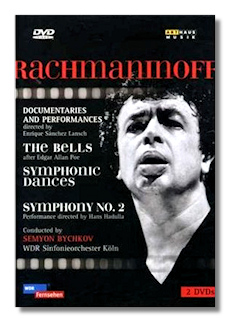
The Internet's Premier Classical Music Source
Related Links
- Rachmaninoff Reviews
- Latest Reviews
- More Reviews
-
By Composer
-
Collections
DVD & Blu-ray
Books
Concert Reviews
Articles/Interviews
Software
Audio
Search Amazon
Recommended Links
Site News
 DVD Review
DVD Review
Sergei Rachmaninoff

- The Bells 1
- Symphony #2
- Symphonic Dances
- Documentaries on the Symphonic Dances and The Bells
1 Tatiana Pavlovskaya, soprano
1 Evgeny Akimov, tenor
1 Vladimir Vaneev, baritone
1 Lege Artis Chamber Choir
1 West German Radio Chorus, Cologne
West German Radio Symphony Orchestra, Cologne/Semyon Bychkov
Arthaus Musik 101439 2DVDs 255:00 Dolby Digital Full Screen
Bychkov has been Chief Conductor of the WDR (West German Radio) Symphony Orchestra in Köln (Cologne) for more than ten years, and has made many CDs and DVDs with that ensemble. (Before that, he recorded for Philips Classics, primarily with the Berlin Philharmonic and the Orchestre de Paris.)
This set contains three of Rachmaninoff's most popular symphonic works. The Bells is a setting of Konstantin Balmont's Russian adaptation of the poem by Edgar Allan Poe. The four movements are "Sleigh Bells," "Wedding Bells," "Alarm Bells," and "Funeral Bells," and so the music, like the poetry, can be heard as a description of the four stages of life. That's about the same idea that Rachmaninoff had for his Symphonic Dances, originally intended as a ballet, and the last music that he was to compose. He had toyed with naming the three movements "Noon," "Evening," and "Midnight," although this idea was discarded. Still, the germ of the idea remains, if one cares to listen for it. In the last movement, Rachmaninoff brings back the Dies irae – the sinister plainchant describing the "Day of Wrath" – one last time. It had obsessed him throughout his life. (It plays a prominent role as far back as his Symphony #1.) The Symphony #2 is moody but ultimately triumphant in spirit, and it is filled with the long-limbed melodies for which this composer is so famous.
The performances and documentaries of The Bells and the Symphonic Dances are directed by Enrique Sánchez Lansch, who takes a somewhat unusual approach. The "performances" are not concert performances, but what might be dress rehearsals: everyone is in their street clothes, the lights are up, and there is no audience. Excerpts from these same "performances" are used in the documentaries, intercut with three different types of material: 1) period footage of the composer and his milieu (fascinating!), 2) Bychkov's English-language reflections on the composer, his life, and the works, and 3) German-language clips with various musicians from the WDR Symphony Orchestra of Cologne, largely reflecting on their careers and on their relationship with the Orchestra. I think I see what Lansch is getting at: orchestral musicians go through stages of life too. The documentaries are longer than the works themselves, however, and some viewers might find them not ideally coherent or tedious.
The Second Symphony, directed by Hans Hadulla, looks like a real performance, although one waits in vain for applause, once the symphony comes to an end. The videography often dissects the instruments – the opening shot is of a cello bow, viewed end-on and apparently about to poke our eyes out! There is much superimposition of images too – sometimes as many as three. If you want to get a feel for what an orchestra looks like as it is playing this symphony, you probably won't get it here. Still, it's fun to watch.
Bychkov knows his way around these scores. He resists the temptation to gush and to swoon over Rachmaninoff's melodies, and these performances, while true to the composer's spirit, are relatively restrained. One factor that comes into play is the sound of the orchestra. At least as it has been recorded here, the WDR Symphony Orchestra of Cologne has neither the most luxuriant string section nor the most blended overall sound. (Indeed, I didn't notice this on the few CDs I've heard from this ensemble.) This does tend to go against Rachmaninoff's grain, at least a little. Even the soloists and the chorus take a lighter approach in The Bells. In all three performances, the music loses some of richness and dark colors. Is it bad? No, but I expect that many listeners will retain preferences for CD recordings of these works. What's left, then, is the rather unusual visual element, which tells us as much about members of the WDR Symphony Orchestra of Cologne as it does about Rachmaninoff!
Copyright © 2008, Raymond Tuttle




















